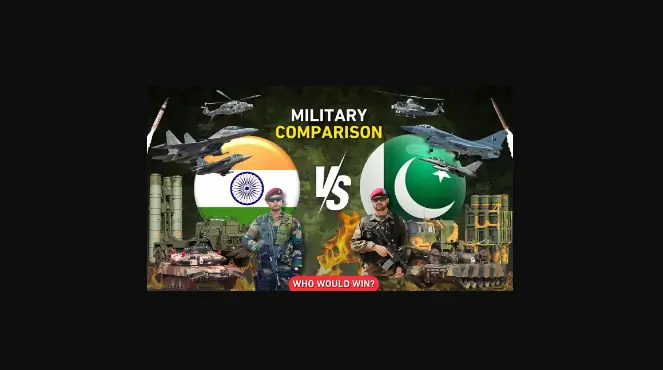India vs Pakistan: A Military Comparison
India and Pakistan: Dissecting Military Strength Through Numbers
Analysing military capabilities on purely numerical grounds requires critical analysis and acknowledging various factors contributing to overall defense effectiveness.
Read More: Iran Attacks Pakistan with Missiles
Here’s a neutral and objective breakdown of India and Pakistan’s military strength based on available data:
Financial Footprint:
- India: Allocated 13% of its budget to defense (5.94 trillion rupees/$73.8 billion), reflecting significant financial investment.
- Pakistan: Maintains a $6.34 billion defense budget, showcasing a smaller expenditure compared to India.
Global Ranking:
- India: Currently ranked as the fourth strongest military in the world by the Global Firepower Index (a data platform analyzing conventional war-fighting capabilities).
- Pakistan: Positioned at number nine on the same index, indicating a perceived gap in overall military strength compared to India.
Manpower Potential:
- India: Boasts a large young population, providing over 65 million available manpower for military service.
- Pakistan: Holds a sizeable number with over 10 million potentially available for military service.
Metrics to Consider:
- The Global Firepower Index considers 60+ factors beyond just financials and manpower, including factors like technological advancements, military infrastructure, resource logistics, and geographical terrain.
- Comparing military strength solely on financial or manpower metrics offers a limited perspective and neglects other crucial aspects of defense capabilities.
Beyond the Numbers:
- Assessing true military preparedness involves understanding factors like troop morale, combat experience, leadership strategies, and the effectiveness of military equipment.
- Additionally, geopolitical alliances, diplomatic relations, and internal political stability play significant roles in shaping overall defense effectiveness.
Moving Forward:
- Analyzing military strength through a purely numerical lens can be misleading and incomplete.
- A comprehensive understanding requires acknowledging the complex interplay of financial resources, manpower potential, logistical capabilities, and various other factors beyond simple numbers.
A Look at India and Pakistan’s Airpower
Delving into the specifics of airpower reveals interesting points of comparison between India and Pakistan’s military capabilities.
Numerical Advantage:
- India: Boasts a sizeable air force with 2,296 aircraft, securing it the fourth place in global ranking.
- Pakistan: Maintains a respectable fleet of 1,434 aircraft, occupying the 25th position on the global stage.
Fighter Jet Arsenal:
- India: Possesses 606 fighter jets deployed across 31 squadrons, with advanced planes like Tejas Mk1 and Mk1A entering service soon. However, aging aircraft like MiG-21Bison and Jaguars pose replacement challenges.
- Pakistan: Fields 387 fighter jets, boasting a diverse fleet featuring Chinese, French, and American models. While Pakistan edges out in attack helicopters, India enjoys an advantage in special mission, aerial tanker, and transport aircraft.
Beyond Numbers:
- Analyzing airpower goes beyond mere quantity. factors like:
- Modernization and technological advancements: Evaluating the quality and capabilities of airbases, avionics, and weaponry provides a more nuanced picture.
- Pilot training and expertise: Assessing the skill and combat experience of pilots plays a crucial role in determining effectiveness.
- Maintenance and operational readiness: Ensuring operational readiness and efficient maintenance of the fleet significantly impacts overall airpower potential.
Understanding the Context:
- Comparing airpower capabilities requires acknowledging the larger geopolitical and strategic context. Factors like:
- Geographical terrain and operational environment influence engagement strategies and equipment needs.
- Defense alliances and technology partnerships contribute to technological advancements and operational capabilities.
Moving Forward:
- Analyzing airpower purely through numerical comparisons offers a limited perspective.
- A comprehensive understanding demands considering various factors beyond numbers, including technological modernization, pilot expertise, logistical capabilities, and the broader geopolitical context.
From War Elephants to Steel Beasts: Analyzing the Ground Game
Shifting our focus to land warfare reveals another aspect of the military capabilities of India and Pakistan. Here’s a neutral and objective look at their respective strengths:
Armored Forces:
- Tanks: India leads with 4,614 tanks, ranking sixth globally, while Pakistan trails with 3,742.
- Armored Vehicles: India boasts a substantial advantage with 1,51,248 armored vehicles compared to Pakistan’s 51,972, translating to a crucial edge in troop deployment and battlefield maneuverability.
Artillery Advantage:
- Self-propelled Systems: Interestingly, Pakistan holds a surprising lead with 612 self-propelled artillery systems, significantly outnumbering India’s 140.
- Towed Artillery: Both nations maintain comparable numbers of towed artillery guns.
Historical Context:
- Sun Tzu’s observation in “The Art of War” highlights the importance of occupying the battlefield proactively, hinting at the significance of armored vehicles in modern warfare.
- The Kargil conflict serves as a reminder of the critical role artillery plays in suppressing enemy positions, exemplified by the effectiveness of Bofors guns in securing Indian victories.
Beyond the Numbers:
- Analyzing ground strength requires considering more than just numerical comparisons. Factors like:
- Modernization and technological advancements: Assessing the capabilities and quality of equipment like tanks and artillery systems is crucial.
- Troop training and operational readiness: Evaluating the skill and preparedness of ground forces significantly impacts effectiveness.
- Terrain and tactical strategies: Adapting to specific geographical environments and employing effective deployment strategies play vital roles in determining operational success.
Moving Forward:
- A comprehensive understanding of ground warfare capabilities demands looking beyond mere numbers.
- Examining factors like technological advancements, troop expertise, tactical strategies, and the specific battlefield context provides a more accurate and nuanced picture of the true strengths and limitations of both nations’ ground forces.
Navigating the Seas: Comparing India and Pakistan’s Naval Presence
Shifting our focus to maritime capabilities, we encounter another vital aspect of military strength: naval power. Here’s a neutral analysis of India and Pakistan’s presence at sea:
Fleet Size and Reach:
- India: Possesses a significantly larger and more diverse fleet with 294 vessels compared to Pakistan’s 114.
- Pakistan: Focuses more on coastal defense with a “Green-water Navy” primarily operating within its regional waters.
Dominant Presence:
- India: Boasts two aircraft carriers (INS Vikramaditya and INS Vikrant), granting its navy “Blue-water” capabilities to project power and operate globally.
- Pakistan: Lacks aircraft carriers, limiting its operational range and global influence.
Strategic Implications:
- India’s extensive coastline and economic interests across the Indian Ocean demand a strong navy, reflected in its larger fleet and focus on blue-water capabilities.
- Pakistan’s geographical location and strategic priorities necessitate a robust coastal defense, influencing its green-water naval focus.
Beyond the Numbers:
- Analyzing naval strength requires looking beyond mere vessel count. Factors like:
- Modernization and technological advancements: Assessing the capabilities and quality of ships, submarines, and weaponry provides a more nuanced picture.
- Personnel training and operational readiness: Evaluating the skill and preparedness of naval personnel significantly impacts effectiveness.
- Tactical strategies and operational doctrines: Understanding how each navy utilizes its capabilities to secure maritime interests is crucial.
By examining various metrics and avoiding biased comparisons, we can gain a more nuanced and accurate picture of India and Pakistan’s military strengths and limitations.
Note: The information above might not be accepted 100%. Please verify from your own sources. We will not be responsible for any kind of loss due to our content.
For more news, please visit Munafa Marketing.




